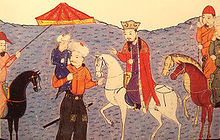Buddhism in Iran: Difference between revisions
Tags: Mobile edit Mobile web edit |
Tags: Mobile edit Mobile web edit |
||
| Line 5: | Line 5: | ||
==History== |
==History== |
||
===Pre |
===Pre-Islamic Iran=== |
||
Buddhism became widespread in parts of [[Persia]] within a few hundred years after its emergence in [[India]]. The [[Maurya Empire]] helped to spread it throughout modern day [[Iran]]. A great number of Buddhist missionaries were sent to spread the teachings of Buddha, and Buddhism became the religion of the eastern Iranian province of [[Khorasan]]. |
|||
In [[Persia]], there was a mixture of languages, religions, and cultures, and, as [[Buddhism]] interacted with these various traditions. Such as [[Shamanism]], [[Zoroastrianism]], [[Christianity]], and later [[Islam]] all coexisted with Buddhism before it decline. There is also evidence of some degree of syncretism between [[Buddhism]] and [[Manichaeism]], an Iranian dualistic religion that was founded in the 3rd century CE. |
|||
==Co exist== |
==Co exist== |
||
Revision as of 00:53, 15 January 2015

Buddhism in Iran may date as far back as the 5th or 6th century BCE, during the life of the historical Buddha Sakyamuni. A Pali legend suggests that the spread of Buddhism to Balkh was initiated by two merchant brothers from Bactria (present-day Afghanistan).[1]
From the 2nd century Parthians such as An Shigao, were active in spreading Buddhism in China. Many of the earliest translators of Buddhist literature into Chinese were from Parthia and other kingdoms linked with present-day Iran.[2]
History
Pre-Islamic Iran
Buddhism became widespread in parts of Persia within a few hundred years after its emergence in India. The Maurya Empire helped to spread it throughout modern day Iran. A great number of Buddhist missionaries were sent to spread the teachings of Buddha, and Buddhism became the religion of the eastern Iranian province of Khorasan.
In Persia, there was a mixture of languages, religions, and cultures, and, as Buddhism interacted with these various traditions. Such as Shamanism, Zoroastrianism, Christianity, and later Islam all coexisted with Buddhism before it decline. There is also evidence of some degree of syncretism between Buddhism and Manichaeism, an Iranian dualistic religion that was founded in the 3rd century CE.
Co exist
Buddhists were persecuted during the Sasanid rule in the region, who made Zoroastrianism state religion in 224 AD, and thereafter burned many Buddhist sites. Surviving Buddhist sites were later raided in the 5th century by the White Huns.[3] At the time of the Arab conquests in the mid-7th century, much of the eastern Iranian world was mainly Buddhist. Afghanistan is rich in Buddhist sites; others have been found in Turkmenistan, Uzbekistan, Tajikistan, and within Iran itself.[4] The Arab conquests brought the final demise of Buddhism in Eastern Iran and Afghanistan, although in some sites like Bamiyan and Hadda it survived until the 8th or 9th century.[3]
Mongol ruler Ghazan, who received Buddhist education in his youth, converted to Islam in 1310 AD and made it the state religion of the Ilkhanate.[5] He also prohibited the practice of Buddhism, but allowed monks to go into exile into neighboring Buddhist regions.[6] But however in Thailand have lineage between Thai and Iranians, specific in Bunnag family that are Theravada Buddhism.[7]
In recent years, Buddhism has experienced an upsurge of interest among Iranians. Some of the poetry of Sohrab Sepehri shows Buddhist influence, and another major contemporary poet, Ahmad Shamlou, translated a book of Japanese haiku poetry into Persian.[8]
See also
Further Reading
- Mostafa Vaziri (2012). Buddhism in Iran: An Anthropological Approach to Traces and Influences. Palgrave Macmillan. ISBN 9781137022936.
External links
References
- ^ Golestan, Mehrak (December 2004), "History of the Buddhism in Iran", The Iranian, retrieved 2009-01-28
- ^ Willemen, Charles; Dessein, Bart; Cox, Collett; Gonda, Jan; Bronkhorst, Johannes; Spuler, Bertold; Altenmüller, Hartwig, Handbuch der Orientalistik: Sarvāstivāda Buddhist Scholasticism, Brill, pp. 128–130, ISBN 978-90-04-10231-6
- ^ a b Yarshater (1993). The Cambridge History of Iran. Cambridge University Press. pp. 956–7. ISBN 978-0-521-24693-4.
- ^ Richard Foltz, "Buddhism in the Iranian World," The Muslim World 100/2-3, 2010, pp. 204-214
- ^ Dunn, Ross E. (2005), The adventures of Ibn Battuta, a Muslim traveler of the fourteenth century, University of California Press, p. 86, ISBN 978-0-520-24385-9
- ^ Anna Akasoy; Charles Burnett; Ronit Yoeli-Tlalim (2011). Islam and Tibet: Interactions Along the Musk Routes. Ashgate Publishing, Ltd. pp. 10–11. ISBN 978-0-7546-6956-2.
- ^ Iranians in Thailand
- ^ Foltz, pp. 212-213
